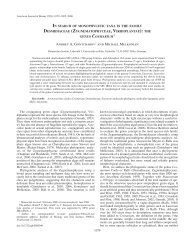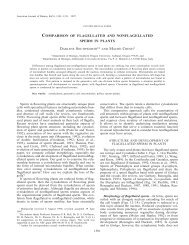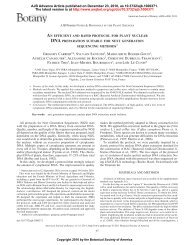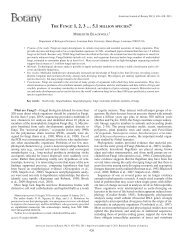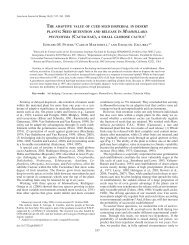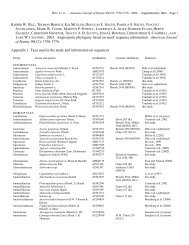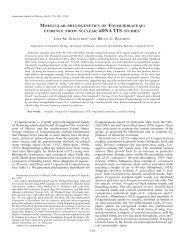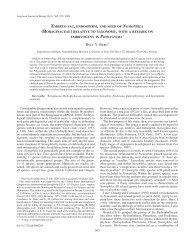View - American Journal of Botany
View - American Journal of Botany
View - American Journal of Botany
You also want an ePaper? Increase the reach of your titles
YUMPU automatically turns print PDFs into web optimized ePapers that Google loves.
<strong>American</strong> <strong>Journal</strong> <strong>of</strong> <strong>Botany</strong> 86(9): 1290–1300. 1999.<br />
PHYLOGENETIC ANALYSES OF ANDROMEDEAE<br />
(ERICACEAE SUBFAM. VACCINIOIDEAE) 1<br />
KATHLEEN A. KRON, 2,3 WALTER S. JUDD, 4 AND DARREN M. CRAYN 5<br />
3 Department <strong>of</strong> Biology, Wake Forest University, Winston-Salem, North Carolina 27109-7325;<br />
4 Department <strong>of</strong> <strong>Botany</strong>, University <strong>of</strong> Florida, Gainesville, Florida 32611-8526; and<br />
5 School <strong>of</strong> Biological Science, University <strong>of</strong> New South Wales, Sydney 2052, Australia<br />
Phylogenetic relationships within the Andromedeae and closely related taxa were investigated by means <strong>of</strong> cladistic<br />
analyses based on phenotypic (morphology, anatomy, chromosome number, and secondary chemistry) and molecular (rbcL<br />
and matK nucleotide sequences) characters. An analysis based on combined molecular and phenotypic characters indicates<br />
that the tribe is composed <strong>of</strong> two major clades—the Gaultheria group (incl. Andromeda, Chamaedaphne, Diplycosia, Gaultheria,<br />
Leucothoë, Pernettya, Tepuia, and Zenobia) and the Lyonia group (incl. Agarista, Craibiodendron, Lyonia, and<br />
Pieris). Andromedeae are shown to be paraphyletic in all analyses because the Vaccinieae link with some or all <strong>of</strong> the<br />
genera <strong>of</strong> the Gaultheria group. Oxydendrum is sister to the clade containing the Vaccinieae, Gaultheria group, and Lyonia<br />
group. The monophyly <strong>of</strong> Agarista, Lyonia, Pieris, and Gaultheria (incl. Pernettya) is supported, while that <strong>of</strong> Leucothoë<br />
is problematic. The close relationship <strong>of</strong> Andromeda and Zenobia is novel and was strongly supported in the molecular (but<br />
not morphological) analyses. Diplycosia, Tepuia, Gaultheria, and Pernettya form a well-supported clade, which can be<br />
diagnosed by the presence <strong>of</strong> fleshy calyx lobes and methyl salicylate. Recognition <strong>of</strong> Andromedeae is not reflective <strong>of</strong> our<br />
understanding <strong>of</strong> geneological relationships and should be abandoned; the Lyonia group is formally recognized at the tribal<br />
level.<br />
Key words: Andromedeae; Ericaceae; Lyonieae; matK; molecular systematics; rbcL.<br />
Andromedeae (13 genera, subfam. Vaccinioideae; see<br />
Stevens 1971, 1995) are a heterogeneous group <strong>of</strong> doubtful<br />
monophyly (Judd and Kron, 1993; Kron and Chase,<br />
1993; Stevens, 1995; Kron, 1996, 1997, and unpublished<br />
data; Kron and Judd, 1997; Kron et al., 1998). Members<br />
<strong>of</strong> this ‘‘group’’ are characterized by alternate leaves with<br />
well-developed blades, usually axillary inflorescences,<br />
sympetalous, urceolate flowers with <strong>of</strong>ten appendaged<br />
anthers, superior ovaries with numerous ovules, and usually<br />
loculicidal capsules. The members <strong>of</strong> this tribe are<br />
distinguished from the phenetically similar Vaccinieae by<br />
their superior (vs. inferior) ovaries and usually dry, capsular<br />
(vs. fleshy, baccate) fruits (Stevens, 1969, 1971,<br />
1995; Anderberg, 1993; Judd and Kron, 1993). They are<br />
easily distinguished from members <strong>of</strong> the Arbuteae,<br />
which also have urceolate corollas and superior ovaries,<br />
by their well-developed, lignified, fiber sheath surrounding<br />
the midrib in the leaves (vs. such fibers poorly developed<br />
or lacking), anthers that become inverted early<br />
in development (vs. inverting only very late), and with<br />
numerous (vs. few or only one) ovules per locule, dry<br />
fruits (vs. fleshy fruits with a prominent layer <strong>of</strong> fibers<br />
around inside <strong>of</strong> pericarp), and the lack (vs. presence) <strong>of</strong><br />
high concentrations <strong>of</strong> ellagic acid (Matthews and Knox,<br />
1 Manuscript received 6 July 1998; revision accepted 23 February<br />
1999.<br />
This study was supported by National Science Foundation grant<br />
DEB-9407350 (KAK). Oligonucleotide synthesis was performed in the<br />
DNA Synthesis Core Laboratory <strong>of</strong> the Cancer Center <strong>of</strong> Wake Forest<br />
University supported in part by NIH grant CA-12197. The authors thank<br />
the following people and institutions for sending herbarium specimens<br />
and providing material for DNA extraction—Roger Hyam, Royal Botanic<br />
Garden, Edinburgh, Royal Botanic Garden, Kew, and New York<br />
Botanical Garden, Kent Perkins for assistance in processing specimens;<br />
and Norris Williams for making available certain computing facilities.<br />
2 Author for correspondence.<br />
1290<br />
1926; Stevens, 1969, 1971; Anderberg, 1993; Judd and<br />
Kron, 1993).<br />
Most genera <strong>of</strong> Andromedeae have been considered in<br />
one <strong>of</strong> two informal subgroups, i.e., the Lyonia group,<br />
comprising Lyonia Nutt. (36 spp.), Craibiodendron W.<br />
W. Smith (five spp.), Pieris D. Don (incl. Arcterica Coville)<br />
(seven spp.), and Agarista (31 spp., incl. Agauria<br />
J. D. Hooker) and the Gaultheria group, including Leucothoë<br />
D. Don (eight spp.), Zenobia D. Don (one sp.),<br />
Gaultheria L. (115 spp.), Pernettya Gaud. (14 spp., but<br />
this genus is <strong>of</strong>ten included within Gaultheria; see Middleton<br />
and Wilcock, 1990a; Middleton, 1991b), Tepuia<br />
Camp (seven spp.), and Diplycosia Blume (97 spp., incl.<br />
Pernettyopsis King and Gamble; see Stevens, 1995) (Stevens,<br />
1970a, 1971, 1995; Judd, 1979; Middleton, 1991a,<br />
b; Kron and Judd, 1997). Andromeda L. (two spp.), Chamaedaphne<br />
Moench. (one sp.), and Oxydendrum DC (one<br />
sp.). have been considered to be taxonomically isolated<br />
(Stevens, 1969, 1971). The Lyonia and Gaultheria groups<br />
are somewhat easier to characterize than the tribe as a<br />
whole. The members <strong>of</strong> the Lyonia group usually have<br />
multicellular hairs with biseriate stalks, slender, geniculate<br />
filaments, and short and rather broad anthers with<br />
white disintegration tissue at the anther–filament junction.<br />
Staminal appendages, when present, are spurs borne<br />
either on the filaments or dorsally on the anthers; the testa<br />
cells are much elongated and have thin walls; the foliar<br />
stomata are usually anomocytic; the upper epidermis <strong>of</strong><br />
the leaf is <strong>of</strong>ten lignified; bands <strong>of</strong> fibers are found in the<br />
secondary phloem; and chromosome numbers are all x <br />
12. In contrast, the members <strong>of</strong> the Gaultheria group can<br />
be characterized by their multicellular hairs with multiseriate<br />
stalks; their stouter, straight filaments; <strong>of</strong>ten longer<br />
anthers with disintegration tissue on the anthers and terminal<br />
awns or lacking both awns and disintegration tis-
September 1999] KRON ET AL.—PHYLOGENETICS OF ANDROMEDEAE<br />
1291<br />
sue; testa cells variable in shape, but <strong>of</strong>ten about as broad<br />
as long and distinctly thickened; <strong>of</strong>ten paracytic stomata;<br />
unlignified cells in the phloem not occurring in bands;<br />
and chromosome base numbers <strong>of</strong> x 11, 12, 13, and<br />
18.<br />
Monophyly <strong>of</strong> the Andromedeae has never been rigorously<br />
assessed. Therefore, in this paper, we focus on<br />
the question <strong>of</strong> the group’s monophyly and its appropriate<br />
circumscription. In addition, we investigate here the<br />
monophyly <strong>of</strong> both the Lyonia group and the Gaultheria<br />
group. The monophyly <strong>of</strong> the Gaultheria group has never<br />
been investigated, while the monophyly <strong>of</strong> the Lyonia<br />
group has been considered only in a preliminary fashion<br />
(Judd, 1979; Kron and Judd, 1997). Selected members <strong>of</strong><br />
the Vaccinieae and Epacridoideae are included in these<br />
cladistic analyses because <strong>of</strong> previous analyses that indicated<br />
a close relationship to members <strong>of</strong> the Andromedeae<br />
(Anderberg, 1993; Kron and Chase, 1993; Kron,<br />
1996, 1997; Kron et al., 1998).<br />
Ericaceae show a great deal <strong>of</strong> morphological variability<br />
and have been well studied from the standpoint <strong>of</strong><br />
morphology, anatomy, embryology, and secondary chemistry<br />
(Niedenzu, 1890; Artopoeus, 1903; Samuelsson,<br />
1913; Matthews and Knox, 1926; Cox, 1948; Palser,<br />
1951, 1952, 1954, 1958, 1961a, b; Chou, 1952; Copeland,<br />
1954; Safijowska, 1960; Paterson, 1961; Wood,<br />
1961; Lems, 1962, 1964; Watson, 1962, 1965; Leins,<br />
1964; Towers, Tse, and Maas, 1966; Harborne, 1969; Stevens,<br />
1969, 1970a, b, 1971; Harborne and Williams,<br />
1973; Villamil and Palser, 1981; Vander Kloet, 1983,<br />
1988; Baas, 1985; Rao and Chakraborti, 1985; Middleton<br />
and Wilcock, 1990a, b; Middleton, 1991a; Odell and<br />
Vander Kloet, 1991; Anderberg, 1994; Powell et al.,<br />
1997). In addition, many <strong>of</strong> the genera considered here<br />
have been recently monographed or are part <strong>of</strong> recent<br />
floristic treatments (Sleumer, 1959, 1966, 1967; Hersey<br />
and Vander Kloet, 1976; Dorr, 1980; Melvin, 1980; Judd,<br />
1981, 1982, 1984, 1986, 1990, 1995a, b, c; Judd and<br />
Hermann, 1990; Luteyn, 1991, 1995a, b, c, 1996; Middleton,<br />
1991b; Luteyn et al., 1996), and their general phylogenetic<br />
placement within the Ericaceae can be assessed<br />
by reference to several higher level phylogenetic analyses<br />
that use morphology (Anderberg, 1993; Judd and Kron,<br />
1993; Kron and Judd, 1997) and rbcL, matK, and nr18s<br />
sequence data (Kron and Chase, 1993; Kron, 1996, 1997,<br />
and unpublished data; Kron and King, 1996; Kron and<br />
Judd, 1997; Kron et al., 1999).<br />
Current studies by Kron (Kron, 1997; Kron and Judd,<br />
1997, and work in progress) indicate that matK is an appropriate<br />
gene to use for phylogenetic analysis in Ericaceae<br />
s.l. (sensu lato). Our knowledge <strong>of</strong> morphological<br />
and molecular variation within the Andromedeae certainly<br />
is now sufficient to undertake phylogenetic analyses<br />
<strong>of</strong> this group, and numerous recent studies have demonstrated<br />
the effectiveness <strong>of</strong> combined analyses <strong>of</strong> phenotypic<br />
and molecular data.<br />
MATERIALS AND METHODS<br />
Representatives <strong>of</strong> all 13 genera <strong>of</strong> Andromedeae were sampled for<br />
this study. Twenty-eight taxa were sampled for the phenotypic cladistic<br />
analyses, while 29 taxa were included in the molecular analyses (Table<br />
1). This study specifically tested the monophyly <strong>of</strong> the tribe Andro-<br />
TABLE 1. Ericalean species included in cladistic analyses <strong>of</strong> the Andromedeae.<br />
All species were used in both morphological and molecular<br />
analyses except Harrimanella hypnoides (see text); Gen-<br />
Bank accession numbers are in brackets. a All species were traditionally<br />
placed in Andromedeae unless otherwise indicated.<br />
Enkianthus campanulatus (Miq.) Nichols—outgroup [matK, GBAN-<br />
U61344; rbcL, GBAN-L12616]<br />
Harrimanella hypnoides (L.) Cov.—outgroup [matK, GBAN-U61315:<br />
rbcL, GBAN-U82766]<br />
Sprengelia incarnata Smith—as representative the epacrid clade, and<br />
as outgroup [matK, GBAN-AF015645; rbcL, GBAN-80421]<br />
Prionotes cerinthoides R. Br.—as representative <strong>of</strong> the epacrid clade,<br />
and as outgroup [matK, GBAN-AF015642; rbcL, GBAN-U79743]<br />
Agarista populifolia (Lam.) Judd [matK, GBAN-U61306; rbcL,<br />
GBAN-AF124589]<br />
Agarista salicifolia (Comm. ex Lam.) G. Don [matK, GBAN-U61313;<br />
rbcL, GBAN-AF124588]<br />
Andromeda polifolia L. [matK, GBAN-AF124569; rbcL, GBAN-<br />
AF124572]<br />
Chamaedaphne calyculata (L.) Moench. [matK, GBAN-AF015630;<br />
rbcL, GBAN-L12606]<br />
Craibiodendron yunnanense W. W. Smith [matK, GBAN-U61307;<br />
rbcL, GBAN-AF124589]<br />
Diplycosia acuminata Becc. [matK, GBAN-AF124563; rbcL, GBAN-<br />
AF124586]<br />
Gaultheria miqueliana Takeda [matK, GBAN-AF124567; rbcL,<br />
GBAN-AF124590]<br />
Gaultheria shallon Pursh [matK, GBAN-AF124565; rbcL, GBAN-<br />
AF124574]<br />
Pernettya tasmanica J.D. Hooker [matK, GBAN-AF124568; rbcL,<br />
GBAN-U82765]<br />
Leucothoë racemosa (L.) Gray [matK, GBAN-AF124564; rbcL,<br />
GBAN-U83915]<br />
Leucothoë fontanesiana (Steudel) Sleumer [matK, GBAN-AF124570;<br />
rbcL, GBAN-AF124585]<br />
Lyonia ligustrina (L.) DC. [matK, GBAN-U61311; rbcL, GBAN-<br />
AF124578]<br />
Lyonia ferruginea (Walter) Nutt. [matK, GBAN-U61312; rbcL,<br />
GBAN-AF124584]<br />
Lyonia lucida (Lam.) K. Koch [matK, GBAN-U61308; rbcL, GBAN-<br />
U82764]<br />
Lyonia ovalifolia (Wallich) Drude ([matK, GBAN-U61305; rbcL,<br />
GBAN-AF124580]<br />
Oxydendrum arboreum (L.) DC. [matK, GBAN-AF124562; rbcL,<br />
GBAN-AF124583]<br />
Pieris phillyreifolia (W.J. Hooker) DC. [matK, GBAN-U61309; rbcL,<br />
GBAN-AF124573]<br />
Pieris floribunda (Pursh) Bentham and Hooker [matK, GBAN-<br />
U61304; rbcL, GBAN-AF124577]<br />
Pieris formosa (Wallich) D. Don [matK, GBAN-U61303; rbcL,<br />
GBAN-AF124581]<br />
Pieris nana (Maxim.) Makino [matK, GBAN-U61310; rbcL, GBAN-<br />
AF124582]<br />
Satyria warszewiczii Klotzsch [matK, GBAN-U61314; rbcL, GBAN-<br />
AF124579]<br />
Tepuia cardonae A. C. Smith [matK, GBAN-AF124566; rbcL,<br />
GBAN-AF124575]<br />
Vaccinium macrocarpon Aiton [matK, GBAN-U61316; rbcL, GBAN-<br />
L12625]<br />
Vaccinium meridionale Sw. [matK, GBAN-U89759; rbcL, GBAN-<br />
AF124576]<br />
Zenobia pulverulenta (Bartram ex Willd.) Pollard [matK, GBAN-<br />
AF124571; rbcL, GBAN-L12626]<br />
a The prefix GBAN- has been added for linking the online version <strong>of</strong><br />
<strong>American</strong> <strong>Journal</strong> <strong>of</strong> <strong>Botany</strong> to GenBank but is not part <strong>of</strong> the actual<br />
GenBank accession number.
1292 AMERICAN JOURNAL OF BOTANY<br />
[Vol. 86<br />
medeae and thus was not primarily concerned with generic limits. However,<br />
most <strong>of</strong> the genera within the tribe have been monographed and<br />
their monophyly is supported by morphological synapomorphies (Judd<br />
1981, 1982, 1984, 1986, 1995b). As discussed in Kron and Judd (1997;<br />
see also Weins, 1998) supraspecific taxa (i.e., genera and sections) were<br />
represented by particular species.<br />
Character scorings for most <strong>of</strong> the 60 phenotypic characters (i.e.,<br />
morphological, anatomical, and embryological—for convenience hereafter<br />
merely referred to as morphological characters) (Table 2) are based<br />
on the authors’ observations <strong>of</strong> herbarium material and, where possible,<br />
living material, supplemented by revisionary and monographic studies<br />
(see references cited above). Character scorings relating to chromosome<br />
number and chemical features mainly were taken from the literature<br />
(see Table 3).<br />
Most morphological characters were readily divisible into discrete<br />
states, thus avoiding arbitrary decisions relating to state delimitation<br />
(Stevens, 1991). A few problems are noted in Table 3. Some characters<br />
could not be included in the analyses because they showed too much<br />
infrataxon variation or could not be delimited into discrete states, e.g.,<br />
leaf size, inflorescence structure, bracteole position, calyx size, corolla<br />
shape and size, fruit shape, and placenta position. All multistate characters<br />
were considered to be unordered (Table 2). Species varying in<br />
particular characters were scored as ‘‘?’’ (and indicated as ‘‘variable’’<br />
in Table 3).<br />
Total DNA was extracted from fresh or silica-gel dried (Chase and<br />
Hills, 1991) leaves using the modified CTAB (hexadecyltrimethylammonium<br />
bromide) procedure <strong>of</strong> Doyle and Doyle (1987). The matK<br />
gene <strong>of</strong> the chloroplast DNA was amplified by the polymerase chain<br />
reaction (PCR) via the methods described in Olmstead et al. (1992)<br />
using the same parameters as described in Kron et al. (1999). Primer<br />
sequences from Johnson and Soltis (1994, 1995) and Steele and Vilgalys<br />
(1994) were used for matK PCR and sequencing. For the rbcL<br />
gene, primers and PCR protocols followed those <strong>of</strong> Olmstead et al.<br />
(1992). Amplified products were cleaned using Microcon 100 filter<br />
tubes (Fisher Scientific, Atlanta, Georgia). The nucleotide sequencing<br />
was performed at the Wake Forest School <strong>of</strong> Medicine, DNA Core<br />
Laboratory on an ABI 377 Automated DNA Sequencer (Perkin-Elmer,<br />
Foster City, California). Raw sequences (for both rbcL and matK) were<br />
edited using Sequencher 3.0 (Gene Codes Corp., Ann Arbor, Michigan).<br />
The edited sequences were visually aligned.<br />
Voucher information for all taxa sampled in this study can be obtained<br />
from KAK. All sequences can be obtained through GenBank<br />
(Table 1).<br />
Phylogenetic analyses—Analyses <strong>of</strong> morphological data included<br />
representatives <strong>of</strong> outgroups identified as appropriate based on previous<br />
studies (Judd and Kron, 1993; Kron and Chase, 1993; Kron, 1996,<br />
1997; Kron and Judd, 1997). Enkianthus campanulatus, Sprengelia incarnata,<br />
and Prionotes cerinthoides were used as outgroups. [Harrimanella<br />
(used in the molecular analyses) was not used as an outgroup<br />
taxon because its very different morphology makes determining character<br />
homology difficult.] Analyses <strong>of</strong> the morphological data were<br />
rooted with Enkianthus, allowing the remaining outgroup taxa to resolve<br />
simultaneously with the ingroup taxa. The analyses employed the<br />
branch-and-bound algorithm (ie-) with extended branch swapping (bb*)<br />
<strong>of</strong> the Hennig86, version 1.5, computer s<strong>of</strong>tware developed by Farris<br />
(1988), and the branch-and-bound option <strong>of</strong> PAUP (Phylogenetic Analysis<br />
Using Parsimony) 3.1.1. (Sw<strong>of</strong>ford, 1993).<br />
As in the morphological study, analysis <strong>of</strong> molecular data (rbcL and<br />
matK nucleotide sequences) included representatives <strong>of</strong> outgroups identified<br />
as appropriate based on previous studies (Judd and Kron, 1993;<br />
Kron and Chase, 1993) and also on the basis <strong>of</strong> preliminary analysis <strong>of</strong><br />
larger matK and rbcL data sets (Kron et al., 1999). These indicate appropriate<br />
potential outgroups as Enkianthus campanulatus, Harrimanella<br />
hypnoides, Sprengelia incarnata, and Prionotes cerinthoides; the<br />
latter two represent the epacrid clade (see Kron, 1997). Analyses <strong>of</strong> the<br />
molecular data were run with Enkianthus designated as the outgroup,<br />
allowing the remaining outgroup taxa to resolve simultaneously with<br />
the ingroup taxa. The few indels that occurred were treated as missing<br />
data. All characters were weighted equally in all analyses. The analyses<br />
were run using the heuristic search option (MULPARS, TBR, 1000<br />
random replicates) <strong>of</strong> PAUP 3.1.1 (Sw<strong>of</strong>ford, 1993). Three measures <strong>of</strong><br />
internal support were used to assess clade robustness when appropriate:<br />
parsimony jackknife (Farris et al., 1996) bootstrap (100 random replicates,<br />
both analyses) and decay (Autodecay 3.0; Mishler, Donoghue,<br />
and Albert, 1991; Eriksson and Wikstrom, 1995).<br />
Combined parsimony analyses (1000 random replicates, MULPARS,<br />
TBR) based on rbcL matK nucleotide sequences, and rbcL matK<br />
morphological data were performed using Enkianthus campanulatus,<br />
Prionotes cerinthoides, and Sprengelia incarnata, as outgroup taxa (and<br />
analysed by PAUP 3.1.1). Bootstrap (100 replicates) and decay analyses<br />
were performed to assess internal support for relationships obtained in<br />
the heuristic analyses.<br />
RESULTS<br />
Morphological data—The morphological analyses<br />
(Hennig86 and PAUP 3.1.1) resulted in the generation <strong>of</strong><br />
36 equally parsimonious trees <strong>of</strong> 139 steps, a consistency<br />
index (CI) <strong>of</strong> 0.48, and a retention index (RI) <strong>of</strong> 0.68.<br />
The topologies represented in these trees, however, are<br />
all quite similar, differing mainly in the placement <strong>of</strong> Andromeda<br />
and a few members <strong>of</strong> the Gaultheria group.<br />
The strict consensus (Fig. 1) and a representative cladogram<br />
(Fig. 2) are presented.<br />
Oxydendrum consistently is the sister group to all other<br />
ingroup taxa, which are are united on the basis <strong>of</strong> their<br />
inflorescences developing on shoots <strong>of</strong> the previous season<br />
(character no. 22) and the pedicel articulated with the<br />
flower (no. 26). Oxydendrum is quite distinctive because<br />
<strong>of</strong> its Calluna-type pith (no. 2-2), deciduous leaves (no.<br />
10-0), and flowers in which all traces to the floral organs<br />
leave the elongated floral axis separately (Palser, 1952).<br />
The monophyly <strong>of</strong> Vaccinieae (as represented by Vaccinium<br />
macrocarpon, V. meridionale, and Satyria warszewiczii)<br />
is supported by their inferior ovary (no. 46)<br />
and indehiscent fruit (no. 51-2), and this group is represented<br />
in most trees. Fleshy fruits (no. 49) are also synapomorphic<br />
for these species under a DELTRAN (see<br />
Wiley et al. [1991] for discussion <strong>of</strong> ACCTRAN and<br />
DELTRAN) optimization. However, Tepuia sometimes is<br />
placed within this clade, while in other trees it links with<br />
Diplycosia because they share apical connate bracteoles<br />
(no. 25) and methyl salicylate (no. 58). The Diplycosia<br />
Tepuia clade, when present, may be sister to Vaccinieae<br />
(Fig. 2), due, in part, to their anther tubules (no.<br />
41), or placed elsewhere in the tree, but these species are<br />
always phylogenetically adjacent to members <strong>of</strong> Vaccinieae.<br />
Thus, in the strict consensus tree (Fig. 1) the<br />
monophyly <strong>of</strong> Vaccinieae is not evident.<br />
Several genera, i.e., Pieris, Lyonia, Agarista, and<br />
Gaultheria s.l., are consistently indicated as monophyletic.<br />
The monophyly <strong>of</strong> Pieris is supported by the inflorescence<br />
exposed during the winter (no. 23) and valvate<br />
calyx lobes (no. 27). Paired appendages located at the<br />
anther–filament junction (no. 39-1) are also synapomorphic<br />
under a DELTRAN optimization. Synapomorphies<br />
for the species <strong>of</strong> Lyonia include the corolla with<br />
multicellular hairs (no. 31), disintegration tissue on the<br />
staminal appendages (no. 43), ovary with multicellular
September 1999] KRON ET AL.—PHYLOGENETICS OF ANDROMEDEAE<br />
1293<br />
TABLE 2. Characters used in morphology-based cladistic analysis <strong>of</strong> Andromedeae. Plesiomorphic characters are listed first, followed by apomorphic<br />
ones. (Polarity decisions based on trees rooted with Enkianthus.)<br />
1. Secondary phloem without bands <strong>of</strong> fibers (0); secondary phloem with bands <strong>of</strong> fibers (1).<br />
2. Pith heterogeneous (0); pith homogeneous (1); pith Calluna-type (2). [unordered]<br />
3. Bud scales numerous to 2, if the latter then minute (0); bud scales 2, enlarged (1).<br />
4. Leaves convolute in bud (0); leaves revolute in bud (1).<br />
5. Leaves alternate (0); leaves whorled (1).<br />
6. Leaf venation pinnate (0); leaf venation parallel (1).<br />
7. Vein reticulum open, the secondary and tertiary veins not equally prominent (0); vein reticulum dense, the secondary and tertiary veins <br />
equally prominent (1).<br />
8. Leaf margin serrate or serrulate (0); leaf margin entire (1).<br />
9. Leaf margin lacking raised glands (0); leaf margin with raised glands (1).<br />
10. Leaves deciduous (0); leaves persistent (1). [polarity questionable; see Table 3]<br />
11. Leaf midrib (as seen in cross section) unifacial (0); leaf midrib bifacial (1).<br />
12. Fiber strands absent from leaf mesophyll (0); fiber strands present in leaf mesophyll (1).<br />
13. Leaf epidermis not lignified (0); leaf epidermis at least slightly lignified (1).<br />
14. Leaf epidermal cells not elongated (as seen in cross section) (0); epidermal cells elongated (1).<br />
15. Hypodermis lacking (0); hypodermis present (1).<br />
16. Multicellular hairs on leaves present (0); multicellular hairs lacking (1).<br />
17. Multicellular hairs with small glandular head (or hairs not glandular) (0); multicellular hairs with expanded and elongated, glandular head (1).<br />
18. Peltate scales lacking (0); peltate scales present (with margin irregular-erose) (1); peltate scales present (with margin entire) (2). [unordered]<br />
19. Stalk <strong>of</strong> multicellular hair multiseriate (0); stalk <strong>of</strong> multicellular hair biseriate (1).<br />
20. Stomata anomocytic (0); stomata paracytic (1); stomata tetracytic (2). [unordered]<br />
21. Inflorescences monotelic, i.e., terminal flowers present (0); inflorescences polytelic, i.e., terminal flowers lacking (1).<br />
22. Inflorescences developing (and producing flowers and fruits) on shoots <strong>of</strong> the current season (0); inflorescences developing (and producing<br />
flowers and fruits) on shoots <strong>of</strong> the previous season (1).<br />
23. Inflorescences within bud (0); inflorescences exposed during winter or dormant season (1).<br />
24. Pedicel lacking bracteoles (0); pedicel with two bracteoles (1); pedicel with several bracteoles (2). [unordered]<br />
25. Bracteoles distinct, variably positioned (0); bracteoles connate, apical (1).<br />
26. Pedicel not articulated with flower (0); pedicel articulated with flower (1).<br />
27. Calyx <strong>of</strong> imbricate lobes (0); calyx <strong>of</strong> valvate lobes (1).<br />
28. Calyx lobes brown, dry at maturity (0); calyx lobes usually colorful, fleshy at maturity (1).<br />
29. Adaxial calyx stomata lacking (0); adaxial calyx stomata present (1).<br />
30. Corolla lacking unicellular hairs on inside surface (0); corolla with unicellular hairs on inside surface (1).<br />
31. Corolla lacking multicellular hairs on outer surface (0); corolla with multicellular hairs on outer surface (1).<br />
32. Abaxial corolla stomata present (0); abaxial corolla stomata absent (1).<br />
33. Filaments straight (0); filaments S-shaped (1).<br />
34. Filaments distinct (0); filaments connate (1).<br />
35. Filaments free from corolla (0); filaments adnate to corolla (1).<br />
36. Filaments with unicellular hairs (0); filaments papillose or minutely roughened (1); filaments smooth (2). [unordered]<br />
37. Anthers inverting late in development (0); anthers inverting early in development (1).<br />
38. Anthers with projections (awns or spurs) (0); such projections absent (1).<br />
39. Projections borne on anther, erect to deflexed (0); projections borne at junction <strong>of</strong> anther and filament (1); projections borne on filament (2).<br />
[unordered]<br />
40. Projections single (or lacking) (0); projections divided (1).<br />
41. Tubules on anthers absent (0); tubules on anthers present (1).<br />
42. Disintegration tissue on back <strong>of</strong> anthers absent (0); disintegration tissue present (1).<br />
43. Disintegration tissue not extending onto the spurs (or spurs lacking) (0); disintegration tissue extending onto the spurs (1).<br />
44. Anthers open by longitudinal slits (0); anthers open by ‘‘terminal’’ pores (1).<br />
45. Pollen shed as monads (0); pollen shed as tetrads (or modified tetrads) (1).<br />
46. Ovary superior (0); ovary inferior (1).<br />
47. Ovary lacking multicellular gland-headed hairs (0); ovary with multicellular gland-headed hairs (or homologous hair types, e.g., scales) (1).<br />
48. Locules not divided (0); locules incompletely divided by outgrowth <strong>of</strong> ovary wall (1).<br />
49. Fruit dehiscent (0); fruit indehiscent (1).<br />
50. Fruit lacking thickened sutures (0); fruit with thickened sutures that <strong>of</strong>ten separate from the valves in dehiscence (1).<br />
51. Fruit a capsule (0); fruit a berry (1).<br />
52. Seed with vascular bundle in the raphe (0); seed lacking vascular bundle in the raphe (1).<br />
53. Seed lacking fringe formed from differentiated cells (0); seed with fringe due to expanded and/or elongated, bulging cells (1).<br />
54. Seed lacking tails (0); seed with tails, i.e., expanded portion <strong>of</strong> testa at hilum and chalazal ends (1).<br />
55. Seed lacking unilateral wing (0); seed with unilateral wing (resulting from a flattening <strong>of</strong> chalazal end <strong>of</strong> seed, with cells <strong>of</strong> the wing not<br />
differentiated from those <strong>of</strong> the body) (1).<br />
56. Testa one-layered (except sometimes in the raphe) (0); testa with several cell layers (1).<br />
57. Testa cells isodiametric (in surface view) (0); testa cells much elongated (1).<br />
58. Methyl salicylate lacking (0); methyl salicylate present (1).<br />
59. Basic chromosome number 11 (0); 12 (1); 18 (2). [unordered]<br />
60. Toxic diterpenes <strong>of</strong> andromedotoxin type absent (0); toxic diterpenes <strong>of</strong> andromedotoxin type present (1).
1294 AMERICAN JOURNAL OF BOTANY<br />
[Vol. 86<br />
TABLE 3. Character values for species used in morphology-based cladistic analysis. V condition variable; ? condition unknown or not<br />
applicable.<br />
Species<br />
Character<br />
1 2 3 4 5 6<br />
123456789012345678901234567890123456789012345678901234567890<br />
Enkianthus campanulatus 000000000000000000000000000000000000000000000000000000000000<br />
Prionotes cerinthoides 0100000001011100000000020000000?000211?0000010000001000000?0<br />
Sprengelia incarnata 0100010101001101?0?200020000000?101211?000001000000100001010<br />
Agarista populifolia 1201001V010010000000V10101000000100011?00101100000010000101?<br />
Agarista salicifolia 10010011010010100000110101000000100011?0010110000001000010??<br />
Pieris floribunda 1000001001000000001011110110100100001010010110000001000010?1<br />
Pieris formosa 100000000100100000101111011010010000101001011000000100001011<br />
Pieris phillyreifolia 1000000001001000001011110110100110021010010110000001000000?1<br />
Pieris nana 11001001010010000010111101100001000110100V0110000001000010?1<br />
Craibiodendron yunnanense 11000001011110000010010101000000100111?0010110000001001010??<br />
Lyonia ferruginea 1100000101101000011011010100001010011V2001111010010101001011<br />
Lyonia lucida 110000010110100000101101011000101001102001111010010100001011<br />
Lyonia ligustrina 101000000010V00010101101011000101000102001111010010100001011<br />
Lyonia ovalifolia 111000010V10V000101011010110001010001020011110V0010100001011<br />
Vaccinium macrocarpon 01000001010000000001?00101000000000011?010011100102100000010<br />
Vaccinium meridionale 01000000010000100001110101000000000101010011101102100000010<br />
Satyria warszewiczii 01000001011000000001110101000000010011?01001110010210000V0?0<br />
Leucothoë fontanesiana 020000000100000000011111010000000001100001011000000110000001<br />
Leucothoë racemosa 010000000000000000011111010000000002100001011000000100000001<br />
Andromeda polifolia 0001000101001001?0?011010100010100001000000011000000100010011<br />
Zenobia pulverulenta 100000000000000000001101010000000001100101011000000100000001<br />
Chamaedaphne calyculata 0100001001000000020V11010100000V0002100010011000000100000001<br />
Diplycosia acuminata 01000000010100100001V10111010000V00211?01001100000010000112?<br />
Gaultheria miqueliana 000000000100000000011101010100000001100101011000000100000101<br />
Gaultheria shallon 0000010000100000000011101010101100000100101011000000100000001<br />
Pernettya tasmanica 00000000010000100001?102010101000000100100011000101100000001<br />
Tepuia cardonae 01000001110000100001100111000V0?000011?0100110001011000001??<br />
Oxydendrum arboreum 0200000V000000000001100100000000000011?001011000000100001011<br />
Note: 25: Enkianthus scored as ‘‘0’’ because it has free bracts, which are homologous to bracteoles. 28: the coding <strong>of</strong> this character for members<br />
<strong>of</strong> the Vaccinieae, e.g., Vaccinium and Satyria, is problematic; they are coded as ‘‘0’’ based on the assumption that the colorful, fleshy sepals in<br />
Gaultheria and Diplycosia developed independently from the fleshy fruits <strong>of</strong> Vaccinieae; developmental studies would be useful. 60: See also<br />
Hegnauer (1966) and Anderberg (1993).<br />
hairs (no. 47), and capsule with thickened sutures (no.<br />
50). Paired appendages on the filament (no. 39-2) are an<br />
additional synapomorphy under DELTRAN optimization.<br />
Agarista is supported by the apomorphies <strong>of</strong> leaves revolute<br />
in the bud (no. 4), leaves with a dense vein reticulum<br />
(no. 7), and stamens lacking appendages (no. 38).<br />
Gaultheria is monophyletic if Pernettya (as represented<br />
by P. tasmanica) is included, based on their fleshy calyx<br />
lobes (no. 28).<br />
The Lyonia group is monophyletic in some trees, but<br />
is paraphyletic in others because Andromeda polifolia is<br />
placed within the group (as sister to Agarista). Characters<br />
supportive <strong>of</strong> the monophyly <strong>of</strong> the Lyonia group include<br />
bands <strong>of</strong> fibers in the phloem (no. 1), S-shaped filaments<br />
(no. 33), disintegration tissue on back <strong>of</strong> anthers (no. 42),<br />
and more or less elongated testa cells (no. 57). Members<br />
<strong>of</strong> this group also have leaves with lignified epidermal<br />
cells (no. 13) and anomocytic stomata (no. 20-0). Both<br />
features also occur in Andromeda and in some trees function<br />
as synapomorphies. Generic relationships within the<br />
Lyonia group are poorly resolved, but Craibiodendron is<br />
always sister to Lyonia (Figs. 1, 2), a relationship consistently<br />
supported by their homogeneous pith (no. 2-1)<br />
and bifacial leaf midrib bundles (no. 11).<br />
The Gaultheria group is never monophyletic, although<br />
some <strong>of</strong> these genera, i.e., Gaultheria, Pernettya, Zenobia,<br />
Leucothoë, and also Chamaedaphne, are linked in a<br />
few cladograms by the base chromosome number <strong>of</strong> 11<br />
(no. 59). Gaultheria, Pernettya, and Zenobia <strong>of</strong>ten form<br />
a clade based on the presence <strong>of</strong> forked anther appendages<br />
(no. 40). The monophyly <strong>of</strong> Leucothoë is equivocal,<br />
but L. racemosa and L. fontanesiana are sometimes<br />
linked by their inflorescences that are exposed during the<br />
winter (no. 23), a feature that also evolved in Pieris (Fig.<br />
2).<br />
Finally, although not a major focus in this investigation,<br />
we note that Sprengelia incarnata and Prionotes<br />
cerinthoides form a clade in all trees that is supported by<br />
the lignified leaf epidermis (character no. 13), elongated<br />
epidermal cells (no. 14), pedicel with several bracteoles<br />
(no. 24-2), and smooth staminal filaments (no. 36-2).<br />
These two species represent the epacrid clade (see Crayn<br />
et al., 1996; Powell et al., 1996; Kron, 1997; Kron et al.,<br />
1998).<br />
Molecular data—Analysis <strong>of</strong> the rbcL data resulted in<br />
42 trees (L 503, CI 0.58, RI 0.50). The strict<br />
consensus (Fig. 3) indicates that few clades are well supported<br />
including: Vaccinieae (parjack 94), Lyonia (parjack<br />
99), and the Pieris floribunda P. formosa clade<br />
(parjack 90). Most <strong>of</strong> the structure in this tree collapses<br />
in trees one step longer. By contrast, the result <strong>of</strong> the<br />
matK analysis is much better resolved, especially within<br />
the Lyonia group (Fig. 4). In the matK analysis (four trees<br />
obtained, L 980, CI 0.65, RI 0.62) Vaccinieae<br />
and members <strong>of</strong> the Gaultheria group form a clade
September 1999] KRON ET AL.—PHYLOGENETICS OF ANDROMEDEAE<br />
1295<br />
Fig. 1. Strict consensus <strong>of</strong> all most parsimonious trees (36) from<br />
analysis <strong>of</strong> morphological data. Length (L) 139, Consistency Index<br />
(CI) 0.48, Retention Index (RI) 0.68. Decay values are below lines.<br />
Taxa traditionally placed in the tribe Andromedeae are in boldface.<br />
strongly supported by the data. Within this clade Vaccinieae<br />
are monophyletic and form a polytomy with three<br />
other clades. The sister relationship <strong>of</strong> Andromeda polifolia<br />
and Zenobia pulverulenta is strongly supported by<br />
the matK data and there is strong support for Chamaedaphne<br />
calyculata sister to Leucothoë racemosa. These<br />
results are different from the morphological analysis (Fig.<br />
1) where Andromeda is indicated as more closely related<br />
to the Lyonia group than the Gaultheria group. Similar<br />
to the morphological analysis, Lyonia and Pieris are<br />
monophyletic in the matK analysis. The Lyonia group<br />
(Lyonia, Craibiodendron, Pieris, Agarista) is monophyletic<br />
but not very strongly supported. In both the rbcL<br />
and matK analyses the Gaultheria group is placed in the<br />
same clade with a monophyletic Vaccinieae. In the matK<br />
analysis this large clade is strongly supported. The results<br />
<strong>of</strong> the rbcL analysis indicate only weak support for a<br />
Gaultheria group Vaccinieae clade, with the clade collapsing<br />
in trees one step longer than most parsimonious<br />
(Fig. 3). The Gaultheria group is not supported as monophyletic<br />
by either the rbcL or the matK analyses. Both<br />
analyses indicate a core Gaultheria clade that includes<br />
Tepuia, Diplycosia, Gaultheria, and Pernettya. In the<br />
rbcL analysis Diplycosia is sister to Tepuia, whereas in<br />
the matK analysis Diplycosia is included in a polytomy<br />
containing Gaultheria and Pernettya. However, none <strong>of</strong><br />
these relationships is strongly supported in either analysis.<br />
Combined analysis <strong>of</strong> rbcL and matK data resulted in<br />
four most parsimonious trees (L 1495, CI 0.92, RI<br />
0.58). The strict consensus (Fig. 5) is highly resolved<br />
with Oxydendrum sister to the remaining ingroup taxa.<br />
As in the separate molecular data analyses Agarista,<br />
Lyonia, and Pieris are monophyletic, but in the combined<br />
analysis they each have higher levels <strong>of</strong> support than in<br />
each individual analysis. In the combined rbcL and matK<br />
analysis Vaccinieae are monophyletic and unresolved<br />
with respect to the Andromeda Zenobia clade and the<br />
weakly supported clade that includes Leucothoë, Chamaedaphne,<br />
Tepuia, Diplycosia, Gaultheria, and Pernettya.<br />
In this analysis Gaultheria is paraphyletic with respect<br />
to Pernettya, a relationship also found in the rbcL<br />
and morphological analyses.<br />
Combined molecular and morphological analysis—<br />
This analysis resulted in the generation <strong>of</strong> a single most<br />
parsimonious tree <strong>of</strong> 1565 steps, a consistency index (CI)<br />
<strong>of</strong> 0.61, and a retention index (RI) <strong>of</strong> 0.59 (Fig. 6). The<br />
position <strong>of</strong> Oxydendrum as sister to the remaining ingroup<br />
taxa is strongly supported.<br />
The monophyly <strong>of</strong> the Lyonia group (incl. Agarista,<br />
Craibiodendron, Lyonia, and Pieris) is strongly supported<br />
(d8, 99% bootstrap). Noteworthy morphological features<br />
supportive <strong>of</strong> the monophyly <strong>of</strong> this group include<br />
bands <strong>of</strong> fibers in the phloem (no. 1), leaves with lignified<br />
epidermal cells (no. 13), S-shaped filaments (no. 33), and<br />
more or less elongated testa cells (no. 57). Within this<br />
clade, Agarista likely is sister to Pieris, and Craibiodendron<br />
is weakly supported as the sister group <strong>of</strong> Lyonia.<br />
Agarista, Pieris, and Lyonia are all strongly supported<br />
as monophyletic (Fig. 6); the monophyly <strong>of</strong> Craibiodendron<br />
was not assessed. Cladogram topology within<br />
the Lyonia group was identical to that discovered in our<br />
previous analysis <strong>of</strong> this group (Kron and Judd, 1997),<br />
and that paper should be consulted for a more detailed<br />
discussion <strong>of</strong> these generic and infrageneric relationships.<br />
Vaccinieae form a well-supported clade (d24, 100%<br />
bootstrap) with members <strong>of</strong> the Gaultheria group, Andromeda,<br />
and Chamaedaphne. A significant morphological<br />
synapomorphy <strong>of</strong> this clade is paracytic stomata (no.<br />
20). The Vaccinieae are clearly monophlyetic (d19, 100%<br />
bootstrap) and are supported by the same morphological<br />
characters as in the morphology-based analyses, with the<br />
addition <strong>of</strong> the anther tubules (no. 41). Such tubules evidently<br />
have evolved independently in a few other taxa,<br />
e.g., Chamaedaphne and the Tepuia Diplycosia clade.<br />
The remaining taxa, mainly members <strong>of</strong> the Gaultheria<br />
group, form a very weakly supported clade (d1, 50%<br />
bootstrap), which possibly is supported by the synapomorphy<br />
<strong>of</strong> a base chromosome number <strong>of</strong> 11 (although<br />
Andromeda has x 12). In addition, forked appendages<br />
(no. 40) occur on the anthers <strong>of</strong> Zenobia, Gaultheria, and<br />
Pernettya and may have been lost from the remaining<br />
taxa. Within this group, Andromeda and Zenobia are sister<br />
to a potential clade (d1, 63% bootstrap) containing<br />
Chamaedaphne, Leucothoë, Tepuia, Diplycosia, Gaultheria,<br />
and Pernettya. However, a core element, containing<br />
Diplycosia, Tepuia, Gaultheria, and Pernettya is well<br />
supported (d11, 100% bootstrap). Members <strong>of</strong> this clade<br />
are united by the presence <strong>of</strong> methyl salicylate (lost in<br />
some species <strong>of</strong> Gaultheria and Diplycosia). They may<br />
also share the apomorphy <strong>of</strong> sepals that are fleshy and<br />
colorful, but the latter feature is absent in Tepuia (and in<br />
some species <strong>of</strong> Pernettya) and may have evolved inde-
1296 AMERICAN JOURNAL OF BOTANY<br />
[Vol. 86<br />
Fig. 2. Representative most parsimonious tree (one <strong>of</strong> 36) from the analysis <strong>of</strong> morphological data. Phylogenetically informative characters are<br />
mapped onto the tree using ACCTRAN optimization (DELTRAN optimizations are discussed in the text). Solid bars—unique; hatched bars—occur<br />
more than once in the tree; open bars—reversals. Taxa traditionally placed in the tribe Andromedeae are in boldface.
September 1999] KRON ET AL.—PHYLOGENETICS OF ANDROMEDEAE<br />
1297<br />
Fig. 3. Strict consensus <strong>of</strong> 42 trees found in the parsimony analysis<br />
<strong>of</strong> rbcL data. L 503, CI 0.58, RI 0.50. Decay values are below<br />
lines, and parsimony jackknife values are above lines. Taxa traditionally<br />
placed in the tribe Andromedeae are in boldface.<br />
Fig. 4. Strict consensus <strong>of</strong> four trees found in the parsimony analysis<br />
<strong>of</strong> matK data. L 980, CI 0.65, RI 0.62. Decay values are<br />
below lines, and parsimony jacknife values are above lines. Taxa traditionally<br />
placed in the tribe Andromedeae are in boldface.<br />
Fig. 5. Strict consensus <strong>of</strong> four most parsimonious trees obtained<br />
from the combined analysis <strong>of</strong> rbcL and matK data. L 1495, CI <br />
0.62, RI 0.58. Decay values are below lines, and parsimony jacknife<br />
values are above lines. Taxa traditionally placed in the tribe Andromedeae<br />
in boldface.<br />
pendently in Diplycosia and Gaultheria. Tepuia and Diplycosia<br />
form a moderately well-supported clade (d3,<br />
71% bootstrap) supported by apical connate bracteoles<br />
(#25) and anther tubules (no. 41), as do Gaultheria and<br />
Pernettya (d4, 84% bootstrap), which may be supported<br />
by fleshy, colorful sepals. Gaultheria likely is paraphyletic,<br />
justifying the inclusion <strong>of</strong> Pernettya. The monophyly<br />
<strong>of</strong> Leucothoë is not at all supported.<br />
DISCUSSION<br />
Results <strong>of</strong> phylogenetic analyses based on morphology,<br />
rbcL, and matK sequences (Figs. 1–4) are generally<br />
similar, although analyses based on single character sets<br />
are less well resolved than the combined analyses (Figs.<br />
5–6). We note that the cladogram resulting from the analysis<br />
based on all three data sets, i.e., morphology and<br />
rbcL and matK sequences (Fig. 6), is better resolved and<br />
shows stronger statistical support for the various internal<br />
clades than any other tree produced in our analyses. This<br />
tree strongly supports the monophyly <strong>of</strong> the Lyonia group<br />
(including Lyonia, Craibiodendron, Agarista, and Pieris)<br />
and the Vaccinieae (including numerous inferior-ovaried<br />
genera), but provides only weak support for the Gaultheria<br />
group (circumscribed so as to include Andromeda and<br />
Chamaedaphne, as well as Zenobia, Leucothoë, Diplycosia,<br />
Tepuia, Gaultheria, and Pernettya). Recognition <strong>of</strong>
1298 AMERICAN JOURNAL OF BOTANY<br />
[Vol. 86<br />
Fig. 6. Single most parsimonious tree obtained from the combined<br />
analysis <strong>of</strong> morphology, rbcL, and matK data. L 1565, CI 0.61,<br />
RI 0.59. Decay values are below lines, and bootstrap values are above<br />
lines. Taxa traditionally placed in the tribe Andromedeae are in boldface.<br />
the Andromedeae, as traditionally circumscribed (see Stevens,<br />
1969, 1971, 1995), cannot be maintained, as genera<br />
<strong>of</strong> the Gaultheria group are more closely related to the<br />
Vaccinieae than they are to those <strong>of</strong> the Lyonia group.<br />
The strong support for the Lyonia group in the combined<br />
analysis indicates that the group should be given formal<br />
recognition, and it is here proposed as the tribe Lyonieae—Lyonieae<br />
Kron & Judd, tribus nov. Epidermis foliorum<br />
lignea; filamenta floris plerumque S-formis; testa<br />
cellulis plerumque elongatis. Type genus: Lyonia Nutt.<br />
Other nomenclatural proposals relating to these genera<br />
will be presented in connection with a new classification<br />
<strong>of</strong> the Ericaceae (Kron et al., unpublished data).<br />
The monophyly <strong>of</strong> the Gaultheria group is not supported<br />
in most <strong>of</strong> the analyses and only weakly supported<br />
in the molecular morphology analysis. In the combined<br />
rbcL and matK analysis the Gaultheria group is split into<br />
two clades that are not resolved with respect to Vaccinieae.<br />
Inclusion <strong>of</strong> the morphological data results in only<br />
a weakly supported Gaultheria group. This group needs<br />
further study, especially a more comprehensive sampling<br />
<strong>of</strong> Gaultheria, Pernettya, and Diplycosia. In addition,<br />
Leucothoë appears as paraphyletic or polyphyletic in<br />
most <strong>of</strong> the trees. Exceptions are in some <strong>of</strong> the morphological<br />
trees and in the rbcL analysis. In both cases the<br />
relationship <strong>of</strong> Leucothoë racemosa to L. fontanesiana is<br />
weakly supported.<br />
Andromeda, Chamaedaphne, and Oxydendrum <strong>of</strong>ten<br />
have been considered taxonomically isolated (Palser,<br />
1951, 1952; Stevens, 1969, 1971), but our results support<br />
an isolated position for only Oxydendrum (Fig. 6).<br />
Andromeda has several distinctive features, which<br />
probably represent autapomorphies, e.g., seeds with a<br />
strongly multilayered testa, campylotropous ovules (Palser,<br />
1952), the lack <strong>of</strong> calyx and corolla stomata, and lack<br />
<strong>of</strong> multicellular hairs. The linking <strong>of</strong> this genus with Zenobia<br />
was not anticipated and is not reinforced by any<br />
morphological characters included in our analyses. The<br />
base chromosome number <strong>of</strong> Andromeda, i.e., 12, also is<br />
aberrant given its placement with genera <strong>of</strong> the Gaultheria<br />
group, which are mainly x 11. However, it may be<br />
significant that Zenobia nearly lacks multicellular hairs,<br />
i.e., they are only associated with the leaf serrations, and<br />
if these were lost (as presumably occurred in the ancestors<br />
<strong>of</strong> Andromeda) then this genus, like Andromeda,<br />
would lack such hairs.<br />
Chamaedaphne is distinctive in its floral anatomy, embryology,<br />
campylotropous ovules (Palser, 1951, 1952),<br />
anthers with tubules, and distinctive lepidote indumentum<br />
(composed <strong>of</strong> peltate scales that are different in form<br />
from those <strong>of</strong> Lyonia sect. Lyonia; see Judd, 1979). Both<br />
molecular and morphological analyses place Chamaedaphne<br />
with members <strong>of</strong> the Gaultheria group. It is<br />
placed sister to Leucothoë racemosa in our combined<br />
analysis. Both have stamens with smooth filaments (no.<br />
36-2; see Fig. 4, where feature is homoplasious). Stevens<br />
(1969) noted that ‘‘in stomata, bracteole, seed and general<br />
anatomical characters it shows some similarity to the<br />
Gaultheria group.’’ For example, its stomata are positionally<br />
paracytic and testa cells isodiametric.<br />
Oxydendrum also is phenetically distinctive, mainly<br />
because <strong>of</strong> its floral anatomy (all traces to the floral organs<br />
leave an elongated axis separately; Palser, 1952),<br />
deeply hooked leaf midrib vascular bundle (Stevens,<br />
1969, 1971), anthers with terminal tubules, and terminal<br />
inflorescence that fruits in the same year in which the<br />
shoot on which it is borne was initiated (Lems, 1962).<br />
Cox (1948) considered Oxydendrum in its own tribe because<br />
its wood has a distinctive medullary ray type and<br />
a high percentage <strong>of</strong> porous vessel perforation plates. Our<br />
analyses suggest that these features represent a combination<br />
<strong>of</strong> autapomorphies and retained plesiomorphies.<br />
Our results are in general agreement with those <strong>of</strong> Stevens<br />
(1969, 1971), Judd (1979), and Middleton (1991) in<br />
supporting the recognition <strong>of</strong> two major clades within the<br />
genera traditionally placed within Andromedeae. Clearly,<br />
they also support the hypothesis (see Stevens, 1995) that<br />
the Andromedeae are not monophyletic, since Vaccinieae<br />
are closely related to members <strong>of</strong> the Gaultheria group.<br />
The close relationship <strong>of</strong> Vaccinieae to some genera traditionally<br />
placed within Andromedeae was first noted by<br />
Stevens (1969, 1971), and their phenetic similarity was<br />
evident to Watson, Williams, and Lance (1967).<br />
Higher level phylogenetic analyses <strong>of</strong> Ericaceae based<br />
on both nuclear and chloroplast DNA (see Kron and<br />
Chase, 1993; Kron, 1996, 1997; Kron et al., 1998) support<br />
the existence <strong>of</strong> a clade comprising Oxydendrum, the<br />
Gaultheria group, the Lyonia group, and the Vaccinieae,<br />
i.e., the ingroup taxa <strong>of</strong> the analyses herein presented.<br />
This monophyletic group, which in large part corresponds<br />
to the Vaccinioideae <strong>of</strong> Stevens (1969), probably should<br />
be given subfamilial rank within an expanded Ericaceae
September 1999] KRON ET AL.—PHYLOGENETICS OF ANDROMEDEAE<br />
1299<br />
(see Anderberg, 1993; Judd and Kron, 1993; Kron and<br />
Chase, 1993). The genera comprising this subfamily represent<br />
four clades, here listed in presumed order <strong>of</strong> divergence:<br />
(1) Oxydendrum, (2) Lyonia group, (3) Gaultheria<br />
group (as here recircumscribed), and (4) Vaccinieae.<br />
LITERATURE CITED<br />
ANDERBERG, A. A. 1993. Cladistic interrelationships and major clades<br />
<strong>of</strong> the Ericales. Plant Systematics and Evolution 184: 207–231.<br />
———. 1994. Cladistic analysis <strong>of</strong> Enkianthus with notes on the early<br />
diversification <strong>of</strong> the Ericaceae. Nordic <strong>Journal</strong> <strong>of</strong> <strong>Botany</strong> 14: 385–<br />
401.<br />
ARTOPOEUS, A. 1903. Über den Bau und die Öffnungsweise der Antheren<br />
und Entwicklung der Samen der Erikaceen. Flora 92: 309–<br />
345.<br />
BAAS, P. 1985. Comparative leaf anatomy <strong>of</strong> Pernettya Gaud. (Ericaceae).<br />
Botanische Jahrbücher 105: 481–495.<br />
CHASE, M.W.,AND H. G. HILLS. 1991. Silica gel: an ideal material for<br />
field preservation <strong>of</strong> leaf samples for DNA studies. Taxon 40: 215–<br />
220.<br />
CHOU, Y.-L. 1952. Floral morphology <strong>of</strong> three species <strong>of</strong> Gaultheria.<br />
Botanical Gazette 114: 198–221.<br />
COPELAND, H. F. 1954. Observations on certain Epacridaceae. <strong>American</strong><br />
<strong>Journal</strong> <strong>of</strong> <strong>Botany</strong> 41: 215–222.<br />
COX, H. T. 1948. Studies in the comparative anatomy <strong>of</strong> the Ericales.<br />
II. Ericaceae—subfamily Arbutoideae. <strong>American</strong> Midland Naturalist<br />
40: 493–516.<br />
CRAYN, D. M., K. A. KRON, P.A.GADEK, AND C. J. QUINN. 1996.<br />
Delimitation <strong>of</strong> Epacridaceae: preliminary molecular evidence. Annals<br />
<strong>of</strong> <strong>Botany</strong> 77: 317–321.<br />
DORR, L. J. 1980. The reproductive biology and pollination ecology <strong>of</strong><br />
Zenobia (Ericaceae). Master’s thesis, University <strong>of</strong> North Carolina,<br />
Chapel Hill, NC.<br />
DOYLE, J., AND J. DOYLE. 1987. A rapid DNA isolation procedure for<br />
small quanities <strong>of</strong> fresh leaf tissue. Phytochemical Bulletin 19: 11–<br />
15.<br />
ERIKSSON, T., AND N. WIKSTRÖM. 1995. AUTODECAY, version 3.0.<br />
Stockholm, Sweden.<br />
FARRIS, J. S. 1988. Hennig86 reference, version 1.5. Port Jefferson<br />
Station, NY.<br />
———, V. A. ALBERT, M.KÄLLERSJO, D.LIPSCOMB, AND A. KLUGE.<br />
1996. Parsimony jackknifing outperforms neighbor-joining. Cladistics<br />
12: 99–124.<br />
HARBORNE, J. B. 1969. Gossypetin and herbacetin as taxonomic markers<br />
in higher plants. Phytochemistry 8: 177–183.<br />
———, AND C. A. WILLIAMS. 1973. A chemotaxonomic survey <strong>of</strong><br />
flavonoids and simple phenols in leaves <strong>of</strong> the Ericaceae. Botanical<br />
<strong>Journal</strong> <strong>of</strong> the Linnean Society 66: 37–54.<br />
HEGNAUER, R. 1966. Chemotaxonomie der Pflanzen 4. Daphniphyllaceae-Lythraceae.<br />
Birkhäuser, Basel.<br />
HERSEY, R. E., AND S. P. VANDER KLOET. 1976. Taxonomy and distribution<br />
<strong>of</strong> Gaultheria in the Caribbean. Canadian <strong>Journal</strong> <strong>of</strong> <strong>Botany</strong><br />
54: 2465–2472.<br />
JOHNSON, L.A., AND D. E. SOLTIS. 1994. matK DNA sequences and<br />
phylogenetic reconstruction in Saxifragaceae s.s. Systematic <strong>Botany</strong><br />
19: 143–156.<br />
———. 1995. Phylogenetic inference in Saxifragaceae sensu stricto<br />
and Gilia (Polemoniaceae) using matK sequences. Annals <strong>of</strong> the<br />
Missouri Botanical Garden 82: 149–175.<br />
JUDD, W. S. 1979. Generic relationships in the Andromedeae (Ericaceae).<br />
<strong>Journal</strong> <strong>of</strong> the Arnold Arboretum 60: 477–503.<br />
———. 1981. A monograph <strong>of</strong> Lyonia (Ericaceae). <strong>Journal</strong> <strong>of</strong> the Arnold<br />
Arboretum 62: 63–209, 315–436.<br />
———. 1982. A taxonomic revision <strong>of</strong> Pieris (Ericaceae). <strong>Journal</strong> <strong>of</strong><br />
the Arnold Arboretum 63: 103–144.<br />
———. 1984. A taxonomic revision <strong>of</strong> the <strong>American</strong> species <strong>of</strong> Agarista<br />
(Ericaceae). <strong>Journal</strong> <strong>of</strong> the Arnold Arboretum 65: 255–342.<br />
———. 1986. A taxonomic revision <strong>of</strong> Craibiodendron (Ericaceae).<br />
<strong>Journal</strong> <strong>of</strong> the Arnold Arboretum 67: 441–469.<br />
———. 1990. A new variety <strong>of</strong> Lyonia (Ericaceae) from Puerto Rico.<br />
<strong>Journal</strong> <strong>of</strong> the Arnold Arboretum 71: 129–133.<br />
———. 1995a. 13. Lyonia Nuttall. In J. L. Luteyn [ed.], Ericaceae,<br />
part II—the superior-ovaried genera, 222–294. Flora Neotropica<br />
Monograph 66. New York Botanical Garden, Bronx, NY.<br />
———. 1995b. 14. Agarista D. Don ex G. Don. In J. L. Luteyn [ed.],<br />
Ericaceae, part II—the superior-ovaried genera, 295–344. Flora<br />
Neotropica Monograph 66. New York Botanical Garden, Bronx,<br />
NY.<br />
———. 1995c. 15. Pieris D. Don. In J. L. Luteyn [ed.], Ericaceae part<br />
II—the superior-ovaried genera, 345–350. Flora Neotropica Monograph<br />
66. New York Botanical Garden, Bronx, NY.<br />
———, AND P. M. HERMANN. 1990. Circumscription <strong>of</strong> Agarista bolibiensis<br />
(Ericaceae). Sida 14: 263–266.<br />
———, AND K. A. KRON. 1993. Circumscription <strong>of</strong> Ericaceae (Ericales)<br />
as determined by preliminary cladistic analyses based on<br />
morphological, anatomical, and embryological features. Brittonia<br />
45: 99–114.<br />
KRON, K. A. 1996. Phylogenetic relationships <strong>of</strong> Empetraceae, Epacridaceae,<br />
Ericaceae, Monotropaceae, Pyrolaceae: evidence from nuclear<br />
ribosomal 18s sequence data. Annals <strong>of</strong> <strong>Botany</strong> 77: 293–303.<br />
———. 1997. Exploring alternative systems <strong>of</strong> classification. Aliso 15:<br />
105–112.<br />
———, AND M. W. CHASE. 1993. Systematics <strong>of</strong> the Ericaceae, Empetraceae,<br />
Epacridaceae, and related taxa based upon rbcL sequence<br />
data. Annals <strong>of</strong> the Missouri Botanical Garden 80: 735–<br />
741.<br />
———, AND W. S. JUDD. 1997. [1998.] Systematics <strong>of</strong> the Lyonia<br />
group (Andromedeae, Ericaceae) and the use <strong>of</strong> species as terminals<br />
in higher-level cladistic analyses. Systematic <strong>Botany</strong> 22: 479–<br />
492.<br />
———, AND J. M. KING. 1996. Cladistic relationships <strong>of</strong> Kalmia, Leiophyllum,<br />
and Loiseleuria (Phyllodoceae, Ericaceae) based on rbcL<br />
and nrITS data. Systematic <strong>Botany</strong> 21: 17–29.<br />
———, R. FULLER, D.M.CRAYN, P.A.GADEK, AND C. J. QUINN. 1999.<br />
Phylogenetic relationships <strong>of</strong> epacrids and vaccinioids (Ericaceae<br />
s.l.) based on matK sequence data. Plant Systematics and Evolution<br />
216: in press.<br />
LEINS, P. 1964. Entwicklungsgeschichtliche Studien an Ericales-Blüten.<br />
Botanische Jahrbücher 83: 57–88.<br />
LEMS, K. 1962. Adaptive radiation in the Ericaceae. I. Shoot development<br />
in the Andromedeae. Ecology 43: 524–528.<br />
———. 1964. Evolutionary studies in the Ericaceae. II. Leaf anatomy<br />
as a phylogenetic index in the Andromedeae. Botanical Gazette<br />
125: 178–186.<br />
LUTEYN, J. L. 1991. Key to the subfamilies and genera <strong>of</strong> neotropical<br />
Ericaceae. Nordic <strong>Journal</strong> <strong>of</strong> <strong>Botany</strong> 11: 623–627.<br />
———. 1995a. 16. Tepuia. In J. L. Luteyn [ed.], Ericaceae, part II—<br />
the superior-ovaried genera, 351–364. Flora Neotropica Monograph<br />
66. New York Botanical Garden, Bronx, NY.<br />
———. 1995b. 17. Pernettya. In J. L. Luteyn [ed.], Ericaceae, part<br />
II—the superior-ovaried genera, 365–383. Flora Neotropica Monograph<br />
66. New York Botanical Garden, Bronx, NY.<br />
———. 1995c. 18. Gaultheria. In J. L. Luteyn [ed.], Ericaceae, part<br />
II—the superior-ovaried genera, 384–488. Flora Neotropica Monograph<br />
66. New York Botanical Garden, Bronx, NY.<br />
———. 1996. Ericaceae. In G. Harling and L. Andersson [eds.], Flora<br />
<strong>of</strong> Ecuador 54. Council for Nordic Publications in <strong>Botany</strong>, Copenhagen.<br />
———, W. S. JUDD, S.P.VANDER KLOET, L.J.DORR, G.D.WALLACE,<br />
K. A. KRON, P.F.STEVENS, AND S. E. CLEMANTS. 1996. Ericaceae<br />
<strong>of</strong> the southeastern United States. Castanea 61: 101–144.<br />
MATTHEWS, J. R., AND E. M. KNOX. 1926. The comparative morphology<br />
<strong>of</strong> the stamen in the Ericaceae. Transactions and Proceedings<br />
<strong>of</strong> the Botanical Society <strong>of</strong> Edinburgh 29: 243–281.<br />
MELVIN, N. C. 1980. A systematic investigation <strong>of</strong> the genus Leucothoë<br />
(Ericaceae). Ph.D. dissertation, Miami University, Oxford, OH.<br />
MIDDLETON, D. J. 1991a. Taxonomic studies in the Gaultheria group<br />
<strong>of</strong> genera <strong>of</strong> the tribe Andromedeae (Ericaceae). Edinburgh <strong>Journal</strong><br />
<strong>of</strong> <strong>Botany</strong> 48: 283–306.<br />
———. 1991b. Infrageneric classification <strong>of</strong> the genus Gaultheria L.<br />
(Ericaceae). Botanical <strong>Journal</strong> <strong>of</strong> the Linnean Society 106: 229–<br />
258.
1300 AMERICAN JOURNAL OF BOTANY<br />
[Vol. 86<br />
———, AND C. C. WILCOCK. 1990a. A critical examination <strong>of</strong> the<br />
status <strong>of</strong> Pernettya as a genus distinct from Gaultheria. Edinburgh<br />
<strong>Journal</strong> <strong>of</strong> <strong>Botany</strong> 47: 291–301.<br />
———, AND ———. 1990b. Chromosome counts in the genus Gaultheria<br />
and related genera. Edinburgh <strong>Journal</strong> <strong>of</strong> <strong>Botany</strong> 47: 303–<br />
313.<br />
MISHLER, B. D., M. J. DONOGHUE, AND V. A. ALBERT. 1991. The decay<br />
index as a measure <strong>of</strong> relative robustness within a cladogram. 10th<br />
Willi Hennig Society Meeting, Toronto (Abstract).<br />
NIEDENZU, F. 1890. Über den anatomischen Bau der Laubblätter der<br />
Arbutoideae und Vaccinioideae in Beziehung zu ihrer systematischen<br />
Gruppierung und geographischen Verbreitung. Botanische Jahrbücher<br />
11: 134–263.<br />
ODELL, E. A., AND S. P. VANDER KLOET. 1991. The utility <strong>of</strong> stem<br />
characters in the classification <strong>of</strong> Vaccinium L. (Ericaceae). Taxon<br />
40: 273–283.<br />
OLMSTEAD, R. G., H. J. MICHAELS, K.M.SCOTT, AND J. D. PALMER.<br />
1992. Monophyly <strong>of</strong> the Asteridae and identification <strong>of</strong> their major<br />
lineages inferred from DNA sequences <strong>of</strong> rbcL. Annals <strong>of</strong> the Missouri<br />
Botanical Garden 79: 249–265.<br />
PALSER, B. F. 1951. Studies <strong>of</strong> floral morphology in the Ericales. I.<br />
Organography and vascular anatomy in the Andromedeae. Botanical<br />
Gazette 112: 447–485.<br />
———. 1952. Studies <strong>of</strong> floral morphology in the Ericales. II. Megagametophyte<br />
development in the Andromedeae. Botanical Gazette<br />
114: 33–52.<br />
———. 1954. Studies <strong>of</strong> floral morphology in Ericales. III. Organography<br />
and vascular anatomy <strong>of</strong> several species <strong>of</strong> Arbuteae. Phytomorphology<br />
4: 335–354.<br />
———. 1958. Studies <strong>of</strong> floral morphology in the Ericales. IV. Observations<br />
<strong>of</strong> three members <strong>of</strong> the Gaultherieae. Transactions <strong>of</strong> the<br />
Illinois Academy <strong>of</strong> Sciences 51: 24–34.<br />
———. 1961a. Studies <strong>of</strong> floral morphology in the Ericales. V. Organography<br />
and vascular anatomy in several United States species <strong>of</strong><br />
the Vacciniaceae. Botanical Gazette 123: 79–111.<br />
———. 1961b. Some aspects <strong>of</strong> embryology in the Ericales. Recent<br />
Advances in <strong>Botany</strong> 1: 685–689 (IX International Botanical Congress,<br />
Montreal, 1959). University <strong>of</strong> Toronto Press, Toronto.<br />
PATERSON, B. R. 1961. Studies <strong>of</strong> floral morphology in the Epacridaceae.<br />
Botanical Gazette 122: 259–279.<br />
POWELL, J. M., D. M. CRAYN, P.A.GADEK, C.J.QUINN, D.A.MOR-<br />
RISON, AND A. R. CHAPMAN. 1996. A re-assessment <strong>of</strong> relationships<br />
within Epacridaceae. Annals <strong>of</strong> <strong>Botany</strong> 77: 305–315.<br />
———, D. A. MORRISON, P.A.GADEK, D.M.CRAYN, AND C. J. QUINN.<br />
1997. Relationships and generic concepts within Styphelieae (Epacridaceae).<br />
Australian Systematic <strong>Botany</strong> 10: 15–29.<br />
RAO, T.A., AND S. CHAKRABORTI. 1985. The veinlet syndrome in the<br />
tribe Andromedeae (Ericaceae). Proceedings <strong>of</strong> the Indian Academy<br />
<strong>of</strong> Sciences 94: 639–654.<br />
SAFIJOWSKA, L. D. 1960. Male gametophyte in Enkianthus. Botanical<br />
Gazette 121: 190–195.<br />
SAMUELSSON, G. 1913. Studien über die Entwicklungsgeschichte der<br />
Blüten einiger Bicornes-Types. Svensk Botanisk Tidskrift 7: 97–<br />
188.<br />
SLEUMER, H. 1959. Studien über die Gattung Leucothoë D. Don. Botanische<br />
Jahrbücher 78: 435–480.<br />
———. 1966. Ericaceae. Flora Malesiana series I, 6: 469–668.<br />
———. 1967. Ericaceae. Flora Malesiana series I, 6: 669–914.<br />
STEELE, K.P., AND R. VILGALYS. 1994. Phylogenetic analyses <strong>of</strong> Polemoniaceae<br />
using nucleotide sequences <strong>of</strong> the plastid gene matK.<br />
Systematic <strong>Botany</strong> 19: 126–142.<br />
STEVENS, P. F. 1969. Taxonomic studies in the Ericaceae. Ph.D. dissertation,<br />
University <strong>of</strong> Edinburgh, Edinburgh.<br />
———. 1970a. Agauria and Agarista: an example <strong>of</strong> tropical transatlantic<br />
affinity. Notes <strong>of</strong> the Royal Botanic Garden, Edinburgh 30:<br />
341–359.<br />
———. 1970b. Calluna, Cassiope and Harrimanella: a taxonomic and<br />
evolutionary problem. New Phytologist 69: 1131–1148.<br />
———. 1971. A classification <strong>of</strong> the Ericaceae: subfamilies and tribes.<br />
Botanical <strong>Journal</strong> <strong>of</strong> the Linnean Society 64: 1–53.<br />
———. 1991. Character states, morphological variation, and phylogenetic<br />
analysis: a review. Systematic <strong>Botany</strong> 16: 553–583.<br />
———. 1995. Familial and infrafamilial relationships, In J. L. Luteyn<br />
[ed.], Ericaceae, part II—the superior-ovaried genera, 1–12. Flora<br />
Neotropica Monograph 66. New York Botanical Garden, Bronx,<br />
NY.<br />
SWOFFORD, D. L. 1993. PAUP: Phylogenetic analysis using parsimony,<br />
version 3.1. Computer program distributed by the Illinois Natural<br />
History Survey, Champaign, IL.<br />
TOWERS, G. H. N., A. TSE, AND W. S. G. MAAS. 1966. Phenolic acids<br />
and phenolic glycosides <strong>of</strong> Gaultheria species. Phytochemistry 5:<br />
677–681.<br />
VANDER KLOET, S. P. 1983. The taxonomy <strong>of</strong> Vaccinium sect. Cyanococcus:<br />
a summation. Canadian <strong>Journal</strong> <strong>of</strong> <strong>Botany</strong> 61: 256–266.<br />
———. 1988. The genus Vaccinium in North America. Agriculture<br />
Canada Publication 1828.<br />
VILLAMIL, P.H. DE, AND B. F. PALSER. 1981. Studies <strong>of</strong> floral morphology<br />
in the Ericales. IX. Organography, vascular anatomy and<br />
magagametophyte in three species <strong>of</strong> Gaultherieae. Phytomorphology<br />
30: 250–265.<br />
WAGNER, W. H. 1980. Origin and philosophy <strong>of</strong> the groundplan-divergence<br />
method <strong>of</strong> cladistics. Systematic <strong>Botany</strong> 5: 173–193.<br />
WATSON, L. 1962. The taxonomic significance <strong>of</strong> stomatal distribution<br />
and morphology in Epacridaceae. New Phytologist 61: 36–40.<br />
———. 1965. The taxonomic significance <strong>of</strong> certain anatomical variations<br />
among Ericaceae. Botanical <strong>Journal</strong> <strong>of</strong> the Linnean Society<br />
59: 111–125.<br />
———, W. T. WILLIAMS, AND G. N. LANCE. 1967. A mixed-data approach<br />
to Angiosperm taxonomy: the classification <strong>of</strong> Ericales.<br />
Proceedings <strong>of</strong> the Linnean Society, London 178: 25–35.<br />
WEINS, J. J. 1998. The accuracy <strong>of</strong> methods for coding and sampling<br />
higher-level taxa for phylogenetic analysis: a simulation study. Systematic<br />
Biology 47: 397–413.<br />
WILEY, E. O., D. SIEGEL-CAUSEY, D.R.BROOKS, AND V. A. FUNK. 1991.<br />
The compleat cladist: a primer <strong>of</strong> phylogenetic procedures. University<br />
<strong>of</strong> Kansas Museum <strong>of</strong> Natural History Special Publication<br />
Number 19, Lawrence, KS.<br />
WOOD, C. E., JR. 1961. The genera <strong>of</strong> Ericaceae in the southeastern<br />
United States. <strong>Journal</strong> <strong>of</strong> the Arnold Arboretum 42: 10–80.



